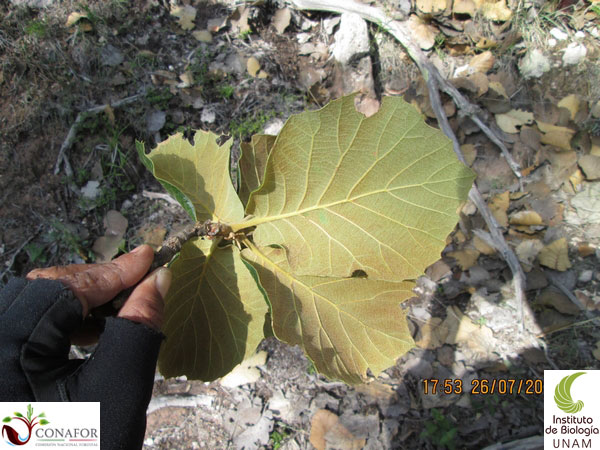| Quercus radiata | |
| Author |
Trel. 1921 Proc. Amer. Philos. Soc. 60: 33 Diagnosis here |
| Synonyms | |
| Local names | |
| Range | Mexico (Durango, Jalisco, Zacatecas); 2000-2600 m; |
| Growth habit | 6-12 m; trunk to 0.5 m in diameter; |
| Leaves | 8-10 x 7-10 cm; oboval to suborbicular; coriaceous; apex obtuse aristate or shortly acuminate; base cordate to auricled; margin flat or slightly revolute, with 4-8 pairs of aristate, short teeth in apical 1/2; adaxially olive green, epidermis reticulate, with trichomes multiradiate (8-10 rays 0.1-0.2 mm long), fascicled ones, stipitate or not, and golden uniseriate glandular ones; abaxially densely tomentose made of fascicled hairs and glandular ones, tomentum which does not hide totally the papillose, reticulate epidermis, becoming somewhat glabrate with dark globules of coalesced glandular excrescence; 8-10 vein pairs, impressed above, prominent beneath; petiole pubescent, brown, 1 cm long; |
| Flowers | |
| Fruits | acorn 6-11 mm, globose, to 8 or more together on the raceme, on a 4-12 cm long infrutescence; cup hemispherical, margin straight, 6-8 mm in diameter, with pubescent scales; cup enclosing 1/3 or 1/2 of the nut; maturation first year; |
|
Bark, twigs and |
bark grey, furrowed into thick plates; twig 5-6 mm thick, pubescent, with pale lenticels; bud ovoid, obtuse, 3-5 mm long, with pubescent scales; stipules 6-10 mm, deciduous, pubescent; |
| Hardiness zone, habitat | |
| Miscellaneous | -- Sub-genus Quercus,
section Lobatae, Series Erythromexicanae, Group Racemiflorae; -- Threatened (IUCN Red List Category : EN). -- Resembles Q. jonesii, but this species has only 1-3 acorns together, stalkless or on a peduncle less than 5 mm long, with fascicled stipitate hairs only at axils, and a smooth surface adaxially; moreover, for some Authors (L. Vazquez & K.C. Nixon 2013) Q. radiata could have a hybrid origin between Q. urbanii (or Q. conzatii) and Q. jonesii. |
| Subspecies and varieties |
|
| Pictures |
More pictures HERE
|
